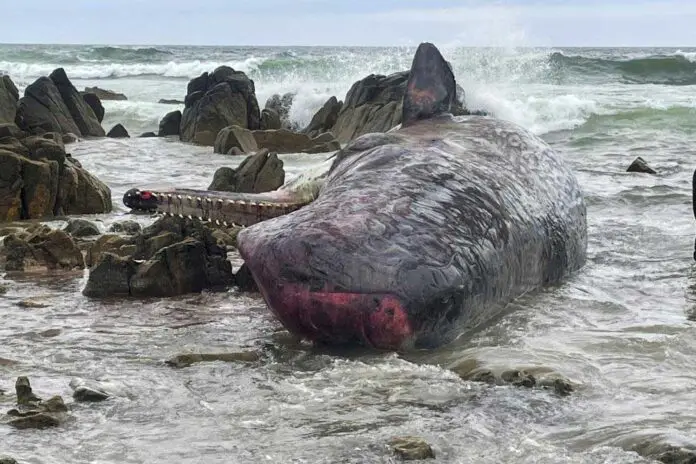A part of a Tasmanian beach was closed off to water sports and the public in the middle of September, due to 14 gigantic whale carcasses that are sadly going to be a presence for a long time.
An investigation is ongoing as to what might have caused the death of 14 young sperm whales discovered washed up on King Island off the coast of Australia.
The State Department of Natural Resources and Environment issued a statement saying that the 14 whales died on King Island, Tasmania.
A team of Australian Marine Conservation Program biologists traveled to Kings Island in order to carry out necropsies on the dead mammals and determine why they died.
Officials plan to conduct an aerial survey of the island to find out whether there were any more whales in the area.
The Department of Natural Resources and Environment said that sperm whales are common in Tasmania, and that the whales frequently are found in the area of King Island.
Svetlana Jacobson, the department’s spokesperson, said that the dead whales could have been part of the same bachelor group, a group of young male sperm whales that swim together after leaving their mothers.
Dr. Vanessa Pirotta, a conservation and technology expert, told ABC News that the cause of whale strandings on King Island remains a mystery. She said that wildlife scientists do not know what causes the whales to be beached. She speculated that the latest stranding incident was due to a navigation error by the whales, or that the group had followed one whale headed to shore, a decision that ended badly.
Kris Carlyon, a wildlife biologist helping to coordinate the response to the incident, said it would be too difficult to remove the whales from the beach, and if they managed to get them back in the water, they would turn up somewhere else and create another problem.
“The preference for us is to let them decompose naturally,” Dr Carlyon said.
“All that nutrient then goes back into the ecosystem and feeds a whole bunch of other animals.”
It could take months before the whales fully decompose, and authorities told the public to keep their distance since the carcasses could carry diseases or crush someone with the moving tides. They also warned people that it was illegal to interfere with protected wildlife, including possessing a dead whale’s body parts.
Swimmers and surfers were advised to avoid the area because there was a possibility that the whale carcasses would attract hungry sharks.
The Tasmanian coast has had several whale strandings over the years, and the 14 dead whales now look like a drop in the ocean compared to hundreds of pilot whales found on the Tasmanian west coast in 2020.
Over 450 long-finned pilot whales were found stranded on Tasmania’s west coast that year. It was the largest mass-stranding ever recorded in Australia. Authorities saved only 111 of those stranded whales after a week-long rescue operation, and 380 of them died.
According to Dr. Carlyon, Tasmania is a hotspot for mass whale strandings because the state’s coastal topography is complex and often acts as a whale trap.

